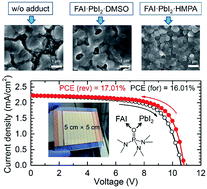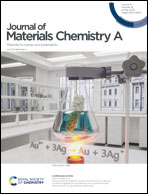17% efficient perovskite solar mini-module via hexamethylphosphoramide (HMPA)-adduct-based large-area D-bar coating†
Abstract
We report a perovskite solar mini-module with power conversion efficiency (PCE) over 17% based on Lewis base additive engineering and large-area D-bar coating. The precursor solutions for the D-bar coating are prepared by mixing home-made powdered FAPbI3 with CsBr and PbBr2 to form the nominal composition of (FAPbI3)0.875(CsPbBr3)0.125, where the Lewis base hexamethylphosphoramide (HMPA) is included as an additive. As compared to the large-area coated perovskite film using the non-additive solution, photovoltaic performance for the perovskite film based on the HMPA-containing solution is much better due to the pinhole-free perovskite morphology and longer carrier lifetime. It is found that HMPA with a higher donor number compared to dimethyl sulfoxide (DMSO) contributes to the formation of a stable adduct intermediate phase to form a dense and uniform perovskite film with high opto-electronic quality. As a result, the 5 × 5 cm2 mini-module demonstrates a PCE of 17.01%, while the small area cell made with pieces of the large-area film shows a PCE of 19.58%. Our study highlights the importance of a stable intermediate for large-area perovskite films.



 Please wait while we load your content...
Please wait while we load your content...